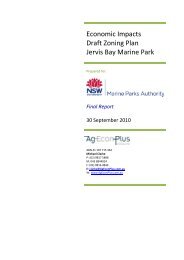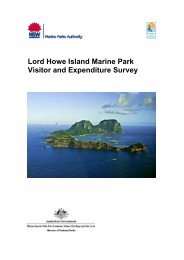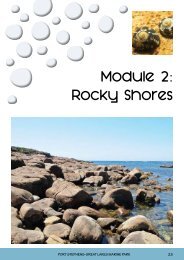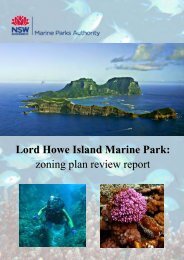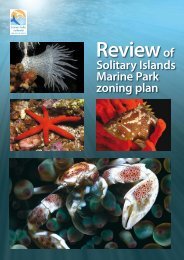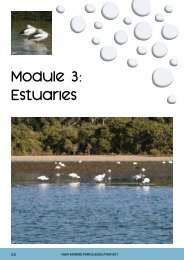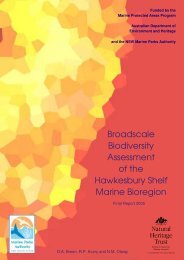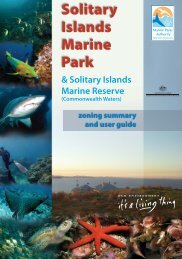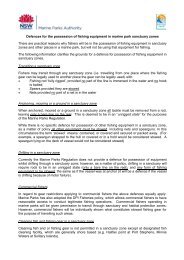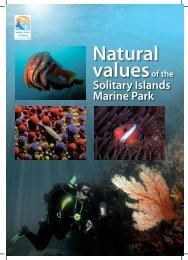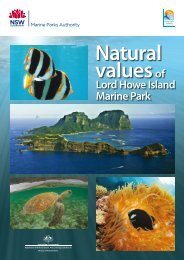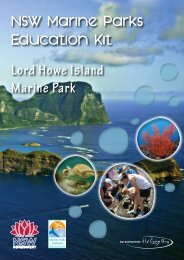Research Project Summaries 2002-2009 - Marine Parks Authority ...
Research Project Summaries 2002-2009 - Marine Parks Authority ...
Research Project Summaries 2002-2009 - Marine Parks Authority ...
Create successful ePaper yourself
Turn your PDF publications into a flip-book with our unique Google optimized e-Paper software.
To further examine the influence of selected physical and biological factors on themarine park’s benthic communities, Harrison (2003) examined the role of habitatcomplexity and wave exposure to determine the structure of benthic macroinvertebratesand demersal fish assemblages, and the population structure of theurchin Centrostephanus rodgersii at South Solitary Island. The study found that habitatcomplexity and wave exposure help structure local patterns of macroinvertebrate anddemersal fish communities over a small spatial scale (hundreds of metres). Thepopulation structure of C. rodgersii was shown to depend on availability of structuralshelter provided by complex habitats. Defining spatial parameters such as seabedcomplexity through swath acoustic mapping will improve understanding of the role suchmorphological variables have on community composition over large spatial scales.Estuarine macrofaunaIn the marine park there are five permanently open estuaries and approximately tenintermittently closed estuaries (i.e. open and closed to coastal waters), some of whichare small. Seasonal sampling of benthic macrofauna was conducted in sixintermittently closed and three permanently open estuaries over two years to examinethe spatial and temporal patterns of community composition (Hastie 2006).Distinct differences were identified between the two estuary types consistent throughtime, despite a high degree of variation between estuaries of the same type (Hastieand Smith 2006). Interestingly, the two estuary types were most similar when all theintermittently closed estuaries were open. These community patterns within andbetween estuary types appear to be driven by catchment size, which influences thelikelihood of entrance closure and, hence, changes in environmental conditions.Temporal changes were most notable in the lower reaches of intermittently closedestuaries, where entrance closure resulted in assemblages becoming eitherdepauperate or dominated by species that were otherwise most commonly recordedfurther upstream. These trends were usually most strongly correlated with variation ineither salinity or sediment, especially organic content.These results confirm an ecological difference between the intermittently closed andpermanently open estuaries In addition to unique communities between estuary types,they also indicate high individuality between estuaries within each type. Suchinformation is important in the zoning process to ensure there is effectiverepresentation of the full range of biodiversity in sanctuary zones.Beach meiofauna variabilitySandy beach meiofaunal communities were examined at two locations (Bell 2005). Inone survey, samples were collected eight times over 128 days to examine temporalvariability. Significant variation was detected, with changes occurring in communitiesbetween each of the eight sampling events. At community level, only a slightcorrelation was found between meiofaunal communities and sediment characteristics,while a strong relationship was seen between populations of some species andsediment characteristics.Spatial variability was examined using a nested design across a number of spatialscales (kilometres, hundreds of metres, tens of metres and tens of centimetres).Variation in the meiofaunal community was detected across all scales, with sedimentcharacteristics (particularly grain size) the major factor in structuring the communityover most spatial scales examined, with strong correlations at the community andtaxon level.Solitary Island and Jervis Bay <strong>Marine</strong> <strong>Parks</strong> <strong>Research</strong> <strong>Project</strong>s <strong>Summaries</strong> <strong>2002</strong>–<strong>2009</strong> 9



